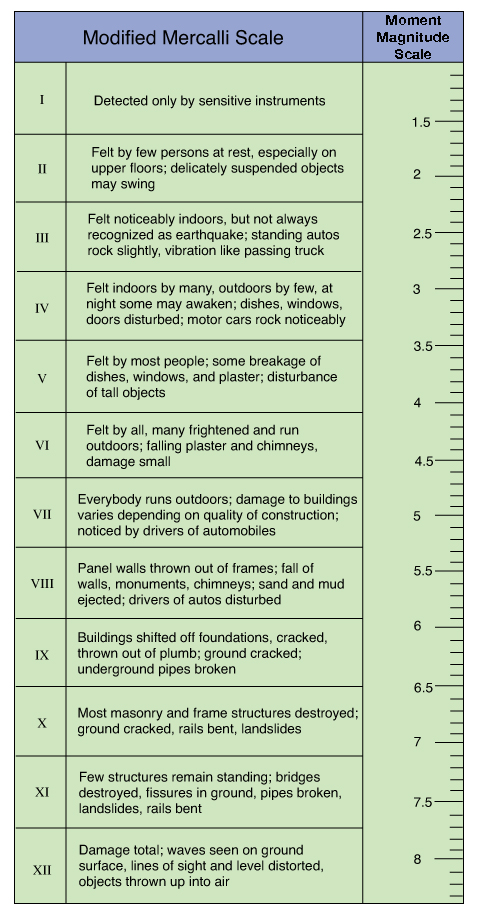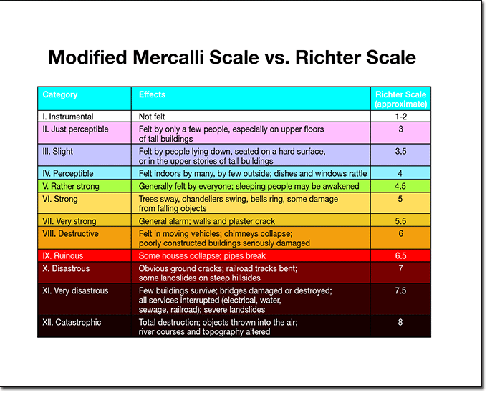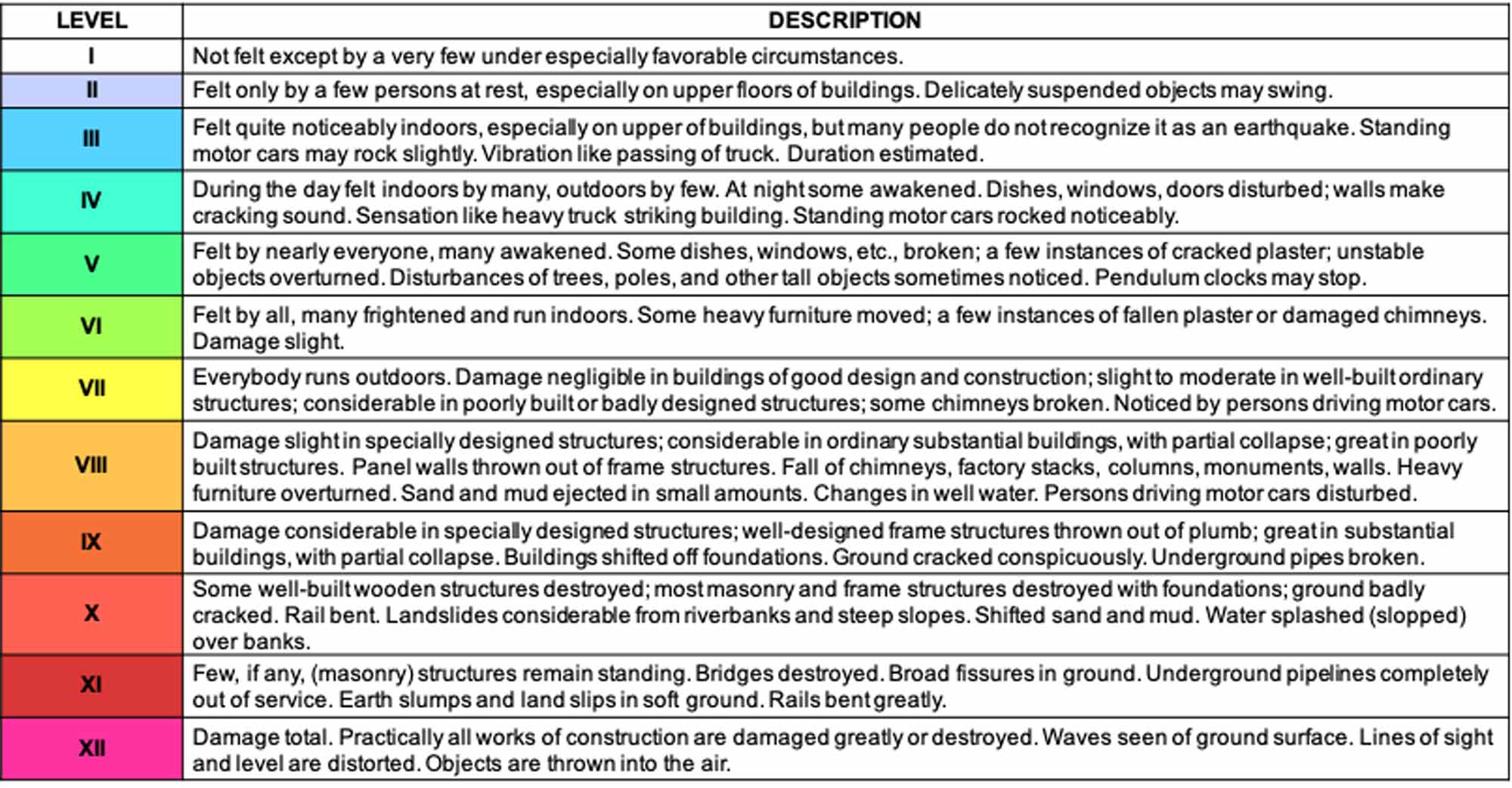On the Modified Mercalli Scale How Is Intensity Xii Described
Unlike with the Richter scale the Mercalli scale does not take into account energy of an earthquake directly. Felt indoors only by a few persons especially on upper floors of buildings.
This scale can vary depending on.

. Modified Mercalli Scale of Earthquake Intensity. A subjective measure that describes how strongly an earthquake was felt at a particular locationThe Modified Mercalli Scale expresses the intensity of an earthquakes effects in a given locality in values ranging from I to XIITable. The Modified Mercalli intensity scale measures the intensity of an earthquakes effects in a given.
The higher end of the scale X-XII describes different levels of ground disruption and destruction that would be found near a fault surface rupture. While an earthquake has only one magnitude it. At high intensities above MMI 6 earthquake shaking damages buildings.
The Mercalli intensity scale was modified in 1931 by American seismologists Harry O. And natural features and varies with location. Intensity is expressed by the Modified Mercalli Scale.
10 rows The 1931 Modified Mercalli scale used in the United States assigns a Roman numeral. It contained 12 levels of intensity. Intensity ratings are expressed as Roman numerals.
Scale ranging from I to XII. In 1931 a modified version of Mercallis scale was published by H. The severity of the.
Not felt except rarely under especially favorable circumstances. If this table is garbled try the plain text version. The Modified Mercalli Scale MM The Mercalli intensity scale is a seismic scale used for measuring the intensity of an earthquake.
Sometimes not recognized to be an. Table 7-1 Modified Mercalli Intensity Scale identifies the level of intensity according to the MMI scale and describes that intensity with respect to how it would be received or sensed by its receptors. Rather they classify earthquakes by the effects they have.
Wood and Frank Neumann to take into account modern structural features. When there is little damage the scale describes how people felt the earthquake or how many people felt it. The Modified Mercalli Intensity Scale is commonly used in the United States by seismologists seeking information on the severity of earthquake effects.
Making Sense of the Modified Mercalli Intensity Scale MMI A Measure of Shaking The Modified Mercalli Intensity MMI estimates the shaking intensity from an earthquake at a specific location by considering its effects on people objects and buildings. Felt indoors by several persons. It is thus depending primarily on the earthquakes magnitude.
The intensity differs from the magnitude which is related to the energy released by an earthquake. Also as in grade I but often more noticeably. Note that the scale is based on vibration experienced at a particular site.
MODIFIED MERCALLI INTENSITY SCALE OF 1931 279 sometimes trees structures liquids bodies of water may sway-- doors may swing very slowly. But this scale also had severe limitations and therefore was superseded in the early 1900s by Mercallis revised intensity scale. Wood and Frank Neumann.
While the perhaps more familiar parameter of magnitude is a measure of the energy that an earthquake releases the intensity of a quake is a measure of the ground shaking severity at a given point. In 1902 the Italian seismologist Mercalli devised a new scale on a I to XII range. There are many scales for intensity but the United States commonly uses the Modified Mercalli scale.
Intensity is a numerical index describing the effects of an earthquake on the surface of the Earth on man and on structures built by man. MMI Value Description of Shaking Severity Summary Damage Description Used on 1995 Maps Full Description I. Not felt except by a very few.
There will actually be a range of intensities within any small area such as a town or county with the. The Modified Mercalli scale is designed to describe the effects of an earthquake at a given place on natural features on industrial installations and on human beings. The 1931 Modified Mercalli scale used in the United States assigns a Roman numeral in the range I - XII to each earthquake effect.
Modified Mercalli Intensity Maps for the February 21 2008 Wells Nevada Earthquake. Modified Mercalli Intensity Scale. The intensities shown on the map below are the highest likely under the most adverse geologic conditions.
Adapted from Siebergs Mercalli-Cancani scale modified and condensed. 13 rows Intensity Shaking Description Image. The middle of the scale VI to IX describes increasing levels of earthquake effects and damage.
II Felt indoors by few especially on upper floors or by sensitive or nervous persons. The Modified Mercalli Scale of Earthquake Intensity In seismology a scale of seismic intensity is a way of measuring or rating the effects of an earthquake at different sites. Motion usually rapid vibration like that of a passing truck.
The Modified Mercalli Intensity Scale MMI In short the intensity of a quake is its effect on the ground at a given point. The Modified Mercalli Intensity Scale is a qualitative scale I-XII of the intensity of ground shaking based on damage to structures and peoples perceptions Figure 538. Delicately suspended objects may swing.
The Mercalli intensity scale is a scale to measure the intensity of earthquakes. It quantifies the effects of an earthquake on the Earths surface humans objects and man-made structures on a scale from I. The Modified Mercalli Intensity MMI scale is commonly used to describe the damage and felt effects of an earthquake at a given location.
The characterization of the impacts of earthquakes generally uses intensity scales describing effects felt in buildings or damage level to these buildings. It is a 12-point scale ranging from sites that experience barely perceptible vibration MM I to those that experience total devastation MM XII. Modified Mercalli Intensity Scale For additional information on statistics on percentage of uninhabitable residential units by construction type and MMI level click here.
Of the two ways to measure earthquake size magnitude based on instrumental readings and intensity based on qualitative effects of earthquakes only intensity can be applied to pre-instrumental earthquakes.

The Modified Mercalli Intensity Mmi Scale Assigns Intensities As U S Geological Survey


Comments
Post a Comment